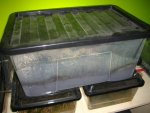catfish dude
New member
Hello,
I've recently purchased a small group of T. shanjing. I thought they will be mature specimens however I done with group of freshly morphed juveniles. They still have remains of gills (small dark spots) in 'used-to-be-gill-rakes'.
I have them for two days and I'm not sure if I'm housing them properly. Also I have a big problem with feeding them.
I've had well prepared vivarium for mature ones with big land area and small body of shallow water however when I saw my tiny animals I immediatelly set up an aquarium with damp paper towel as substrate and few hiding places in rock piles. I know they would probably be better in this setup for mature specimens however they are so tiny and I don't really have much experience in keeping so young caudates I want to monitor them closely for few first week just to be sure they are doing fine and it will be easier in simple setup like paper towel I guess.
What temperature should I keep them in?
I've tried feeding them with live bloodworms (I've had them in refrigerator). One ate about 10. The rest is not interested in feeding at all. They are also rather inactive. Just hiding and not moving much except one specimen which vigorously is patroling his new home, climbing on rocks and so on .
.
Moisure is high (towel is really damp) however this one wandering specimen has rather dry sking (however it looks the happies from the group).
I've seen in other topics photos of feeding juveniles. They were probably eating blackworms which are sadly not available in my part of the world.
Any tips about feeding my little gems?
I have my own setups for crickets, wax worms grindal worms and micro worms however they will be either too big or too small for my animals.
Here are few photos and a movie (sorry for a quality, my camera is down so photos were taken by mobile phone):
YouTube - tylotriton.avi
This is the most active specimen:

This one was eating bloodworms:

Well this is just a tail however it shows how setup looks like

So in conclusion I would like to know what should I feed them with and what temperature should I keep them. Also what should I change in my setup. Add more water?
Also during browsing other topic I found (in different setup) that during leaving water and loosing gills and few first days after metamorphosis juveniles won't eat at all.
Is this also true with this species?
Thanks!
Sumiki info
I've recently purchased a small group of T. shanjing. I thought they will be mature specimens however I done with group of freshly morphed juveniles. They still have remains of gills (small dark spots) in 'used-to-be-gill-rakes'.
I have them for two days and I'm not sure if I'm housing them properly. Also I have a big problem with feeding them.
I've had well prepared vivarium for mature ones with big land area and small body of shallow water however when I saw my tiny animals I immediatelly set up an aquarium with damp paper towel as substrate and few hiding places in rock piles. I know they would probably be better in this setup for mature specimens however they are so tiny and I don't really have much experience in keeping so young caudates I want to monitor them closely for few first week just to be sure they are doing fine and it will be easier in simple setup like paper towel I guess.
What temperature should I keep them in?
I've tried feeding them with live bloodworms (I've had them in refrigerator). One ate about 10. The rest is not interested in feeding at all. They are also rather inactive. Just hiding and not moving much except one specimen which vigorously is patroling his new home, climbing on rocks and so on
Moisure is high (towel is really damp) however this one wandering specimen has rather dry sking (however it looks the happies from the group).
I've seen in other topics photos of feeding juveniles. They were probably eating blackworms which are sadly not available in my part of the world.
Any tips about feeding my little gems?
I have my own setups for crickets, wax worms grindal worms and micro worms however they will be either too big or too small for my animals.
Here are few photos and a movie (sorry for a quality, my camera is down so photos were taken by mobile phone):
YouTube - tylotriton.avi
This is the most active specimen:
This one was eating bloodworms:
Well this is just a tail however it shows how setup looks like
So in conclusion I would like to know what should I feed them with and what temperature should I keep them. Also what should I change in my setup. Add more water?
Also during browsing other topic I found (in different setup) that during leaving water and loosing gills and few first days after metamorphosis juveniles won't eat at all.
Is this also true with this species?
Thanks!
Sumiki info














